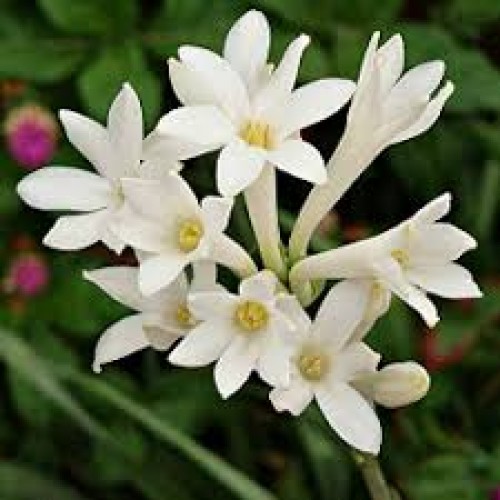60%
off
off
-
Sold
-

out
Rajnigandha Plant (Polianthes tuberosa)
Botanical Features & Nature
- Scientific Name: Polianthes tuberosa
- Common Names: Rajnigandha, Tuberose
- Family: Asparagaceae
- Origin: Native to Mexico; widely cultivated in India and other tropical regions
- Height: Typically grows between 2 to 3 feet (60 to 90 cm)
- Leaves: Long, narrow, and grass-like
- Flowers: White, tubular, and highly fragrant; bloom primarily in the evening and night
- Growth Habit: Perennial herbaceous plant with tuberous roots
Care & Cultivation
- Sunlight: Prefers full sun; requires at least 6 hours of direct sunlight daily
- Soil: Thrives in well-drained, fertile soils rich in organic matter; pH between 6.0 and 7.5
- Watering: Keep soil consistently moist but not waterlogged; water regularly during the growing season
- Fertilization: Apply a balanced fertilizer (e.g., 10-10-10) every 2-3 weeks during active growth
- Temperature: Prefers warm climates; optimal growth between 20°C to 30°C
- Planting Season: Best planted in spring after the last frost; in India, between mid-March and mid-April
- Propagation: Propagated through bulbs or bulb divisions
Uses & Benefits
Medicinal Applications
- Traditionally used for its anti-inflammatory and antibacterial properties
- Employed in treating respiratory issues, such as coughs and congestion
- Utilized in aromatherapy to alleviate stress, anxiety, and insomnia
- Applied in skincare for its moisturizing and anti-aging effects
Environmental Significance
- Attracts pollinators like bees and butterflies, enhancing garden biodiversity
- Contributes to soil health through its tuberous root system
Ornamental & Cultural Importance
- Popular ornamental plant in gardens for its fragrant flowers
- Widely used in floral arrangements, garlands, and religious ceremonies
- Symbolizes purity and love in various cultures
Advantages of Planting Rajnigandha
- Low Maintenance: Requires minimal care once established
- Fragrant Blooms: Produces highly aromatic flowers, especially in the evening
- Versatility: Suitable for garden beds, borders, and containers
- Extended Blooming Period: Flowers can last several weeks, providing prolonged enjoyment
- Aesthetic Appeal: Adds elegance and a pleasant fragrance to any landscape
Cultural Significance
- In Indian culture, Rajnigandha is associated with love and devotion
- Commonly used in weddings, festivals, and religious offerings
- Its fragrance is believed to have calming and purifying effects